Can IT Professionals Change Jobs Without Raising Salaries: Poll Infographic From My Circle
At My Circle, we constantly monitor the recruitment of IT professionals. A simple criterion by which we judge the popularity of a vacancy is the number of responses it receives during the month. What determines the number of responses? What do applicants pay attention to?
The obvious answer is, of course, the salary! Yes, salary is really important, we often talk about it ourselves . But work is not only a place to earn money, but also a place where we spend a significant part of our lives, we communicate with colleagues more and more often than with friends and even family. A third of life, according to the most conservative notions, passes one way or another “at work”.
Do the numbers confirm that it is not only the salary indicated in it that is important for applicants who respond to a vacancy? Yes - we regularly see that the number of responses to the same vacancies, with the same salary, located in the same city, but related to different companies, can differ significantly.
In today's small study, we’ll try to take a closer look at those non-monetary factors that influence job choice. In the first part we will see who is ready to change his current job without changing his salary and why he is ready. In the second - how often new employees come at the invitation of friends and what affects this.

We interviewed more than 1600 people, users of "My circle" and "Habrahabr". We got the usual slice for us, the same as in all our other polls. Most of our respondents are programmers: backend and frontend developers, developers of mobile applications and software.
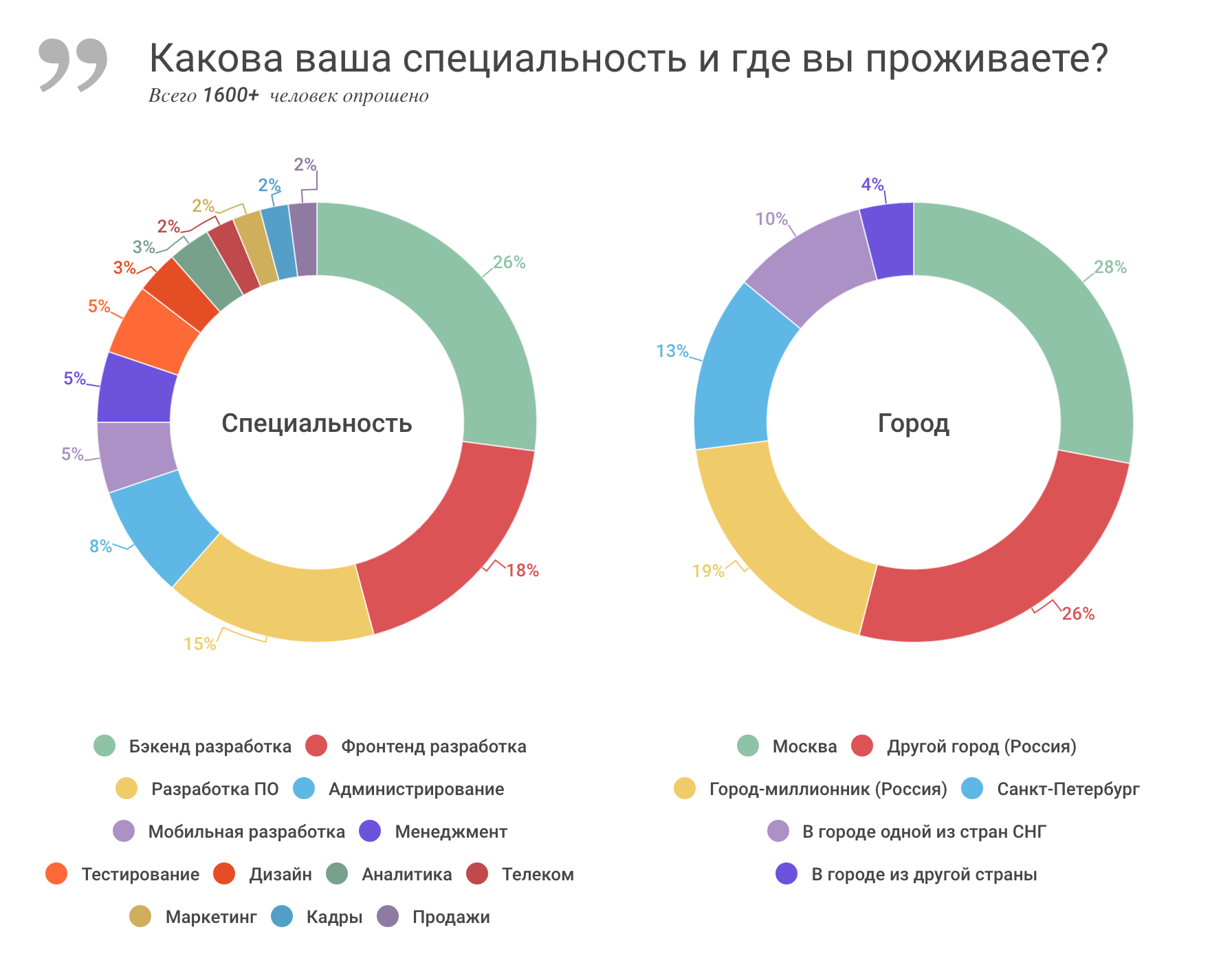
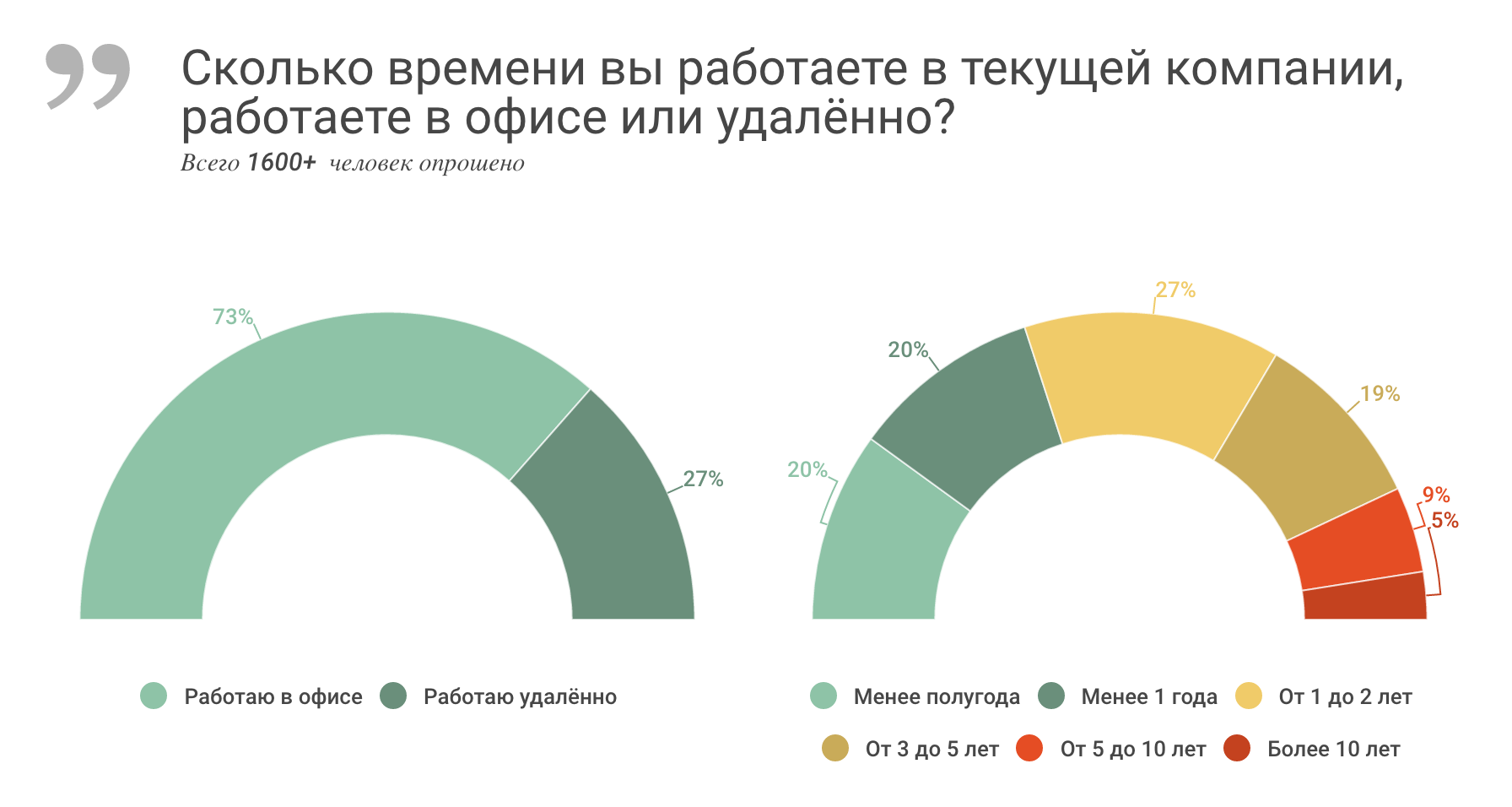
So what factors, in addition to salary, can determine the choice of work for an IT specialist? To find out, we asked everyone to answer the following question and received an appropriate distribution of answers.
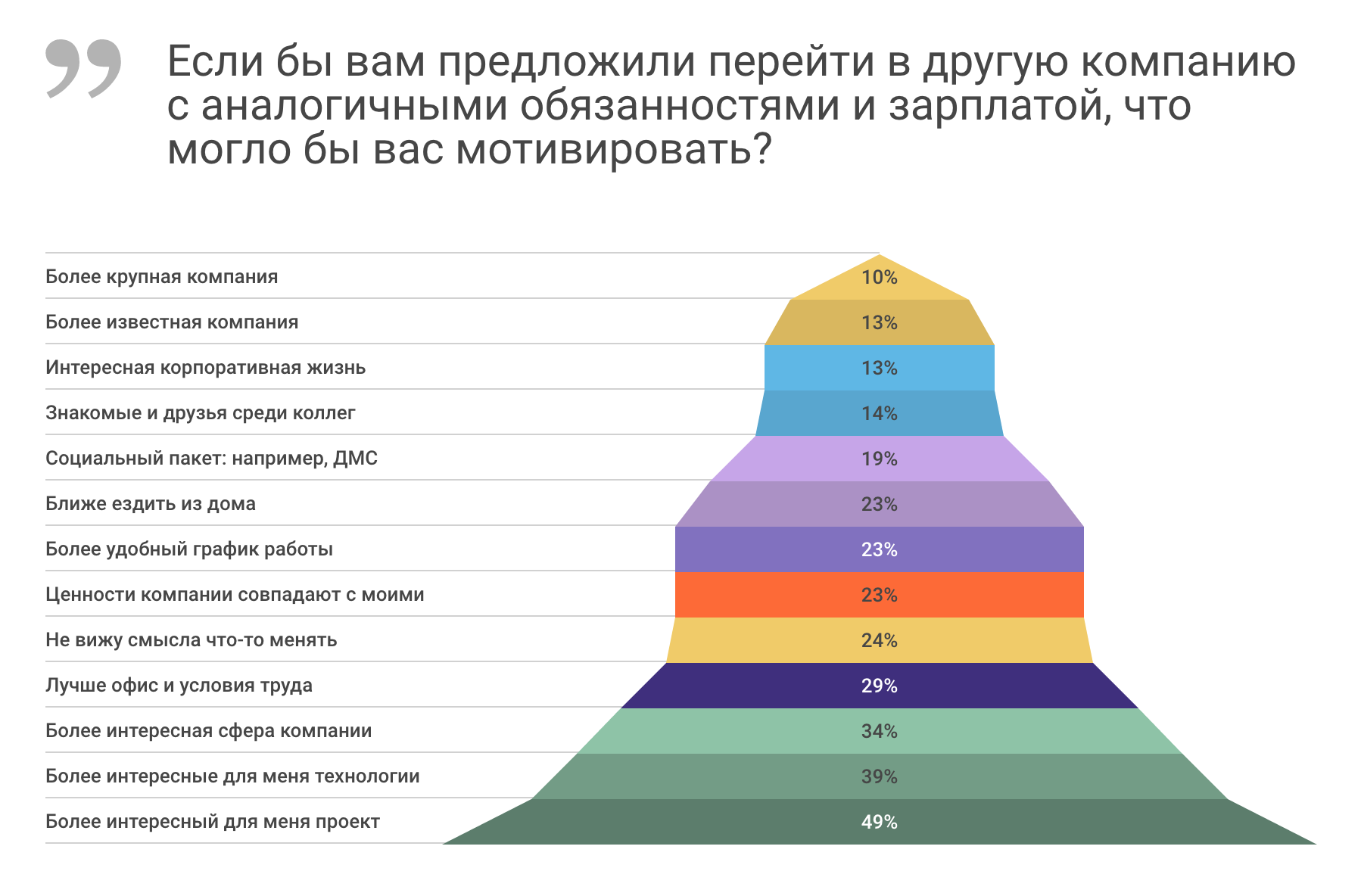
It turned out that salary is the only condition for a job change only for every fourth IT specialist (highlighted in yellow on the diagram). Only 25% of respondents do not see any reason to change jobs if they are offered the same responsibilities with the same salary! For most, there are many other, additional, factors that can affect the final decision on a change of job.
In the first place - professional factors(highlighted in green on the diagram). Every second can go into a more interesting project. Two out of five may be carried away by more interesting technologies. One of the three is a more interesting area of the company.
In second place are comfort factors (highlighted in purple on the diagram). Almost one in three can be tempted by a good office and better working conditions. Every fourth - a more convenient work schedule or proximity to home. Every fifth - the presence of a social package. All these are material factors, somewhat close to salary.
However, this second place is disputed by a completely intangible factor - the value factor (highlighted in orange on the diagram). So, every fourth is ready to change jobs only because the values of the company coincide with his personal.
In third place are communicative factors (highlighted in blue on the diagram). One out of seven can go to another company if his friends are there or if a more interesting corporate life awaits him.
Finally, in fourth place are the factors of the company's prestige (highlighted in yellow on the diagram). One in ten can go without changing their salaries to a larger or more well-known company.
As you can see, most of the factors contributing to the choice of work are intangible or, more precisely, do not always directly correlate with money. If a company wants to attract specialists without increasing salary costs, it must be able to manage these factors and communicate its work advantages hidden from prying eyes.
We looked at the non-salary factors of job change in the industry as a whole. It will also be interesting to see how similar they are depending on the age or field of activity of the specialist.
4 age groups are highlighted below. The height of each color bar shows how many percent of people of a given age indicated that this factor could motivate them to change jobs without increasing their salaries.

As you can see, for young people in their student years more than for other age groups, fame, company size and company values are important, and less than others are important social package or proximity to home .
For the most adults who have crossed the 40-year milestone, closeness to home is more important than others and less importantacquaintances among colleagues, corporate life, fame or company size .
For young people from 20 to 30 years, compared with those who are from 30 to 40, acquaintances among colleagues, corporate life, fame and size of the company are a little more important .
Separate specialties are highlighted below. The height of each color bar shows how many percent of people in a given specialty indicated that this factor could motivate them to change jobs without increasing their salaries.
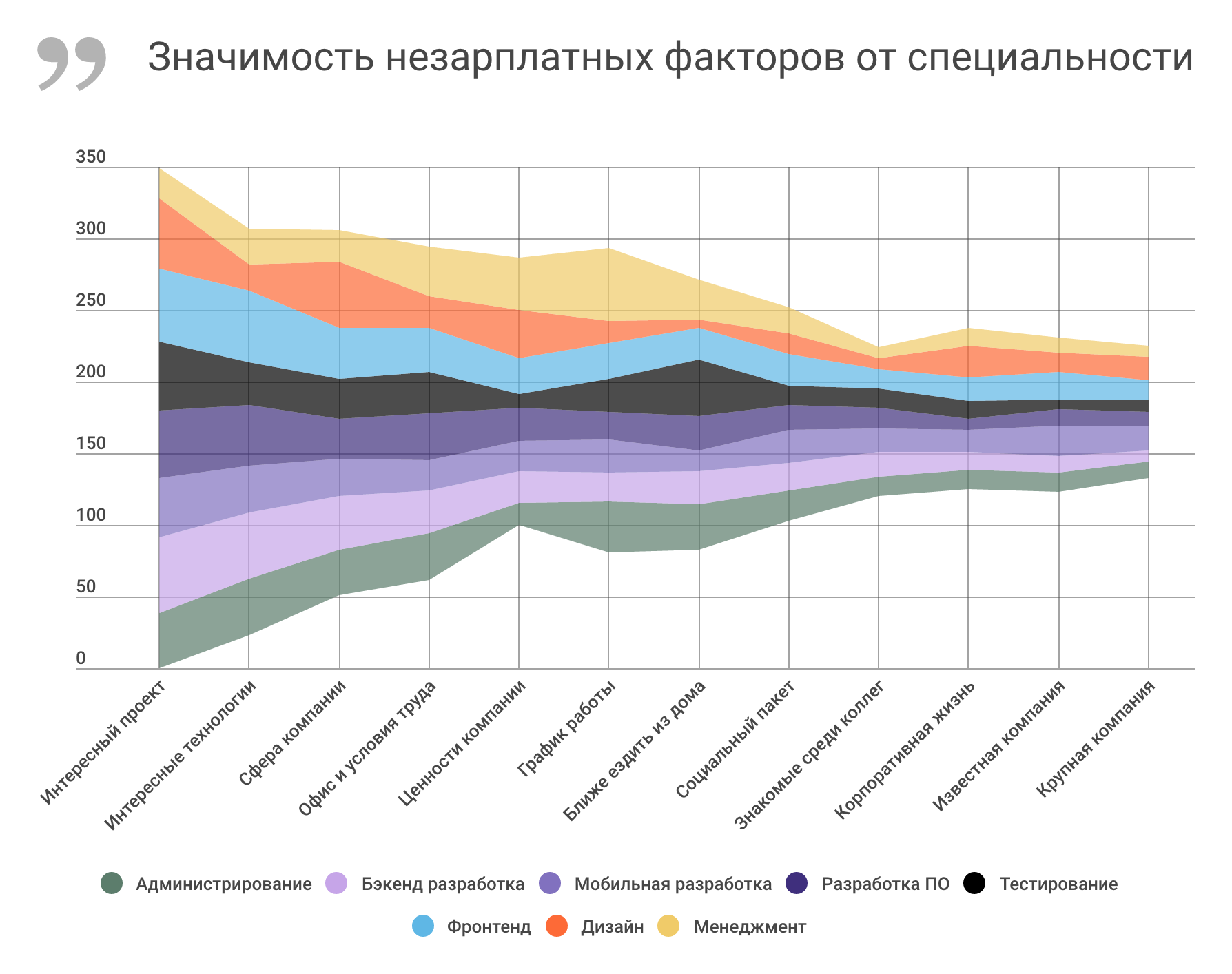
We see that for administrators and testers, in comparison with other specialists, the company's values are less significant, and for managers and designers more significant.
For testers, the proximity of work from homemore important than other professionals, and designers - on the contrary, it is less important than others.
For managers, the work schedule is more important than other specialists, and the interestingness of the project , oddly enough, is less important than others.
For designers and managers, interesting technologists are less important than other specialists, which is understandable, they do not work with code.
How do companies manage to convey their work advantages to their potential employees? To find out, we asked the following question.
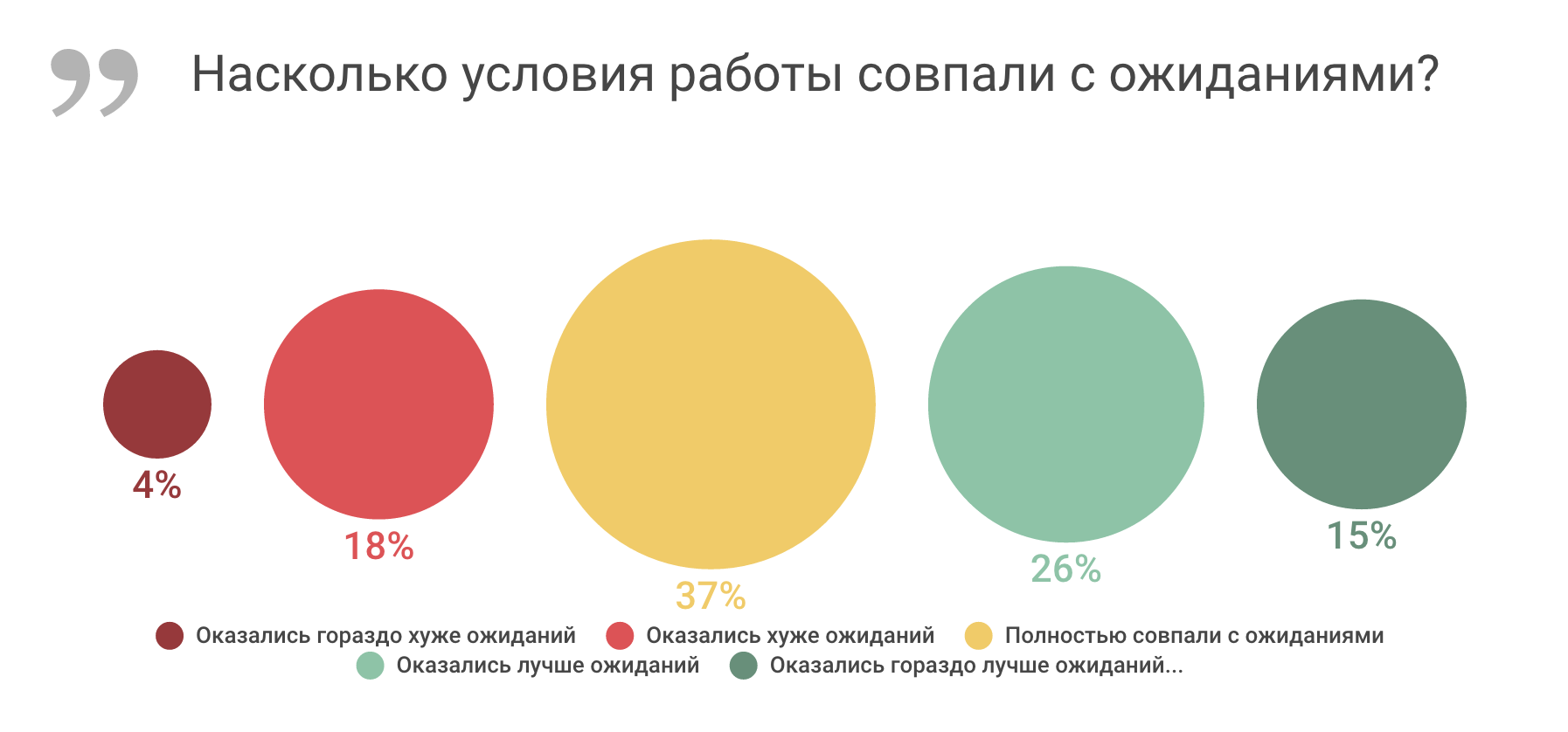
It turned out that for more than 40% of respondents, their ideas about the working conditions in the current company were worse than they really are. This suggests that very, very many companies do not inform applicants of their advantages and advantageous qualities. Recently, by the way, we wrote about how it is worth communicating to an IT professional the benefits of a company using the example of registering a company profile on My Circle.
In the second part of our study, we’ll try to figure out how IT specialists learn about their future work and what role word of mouth plays in this process.
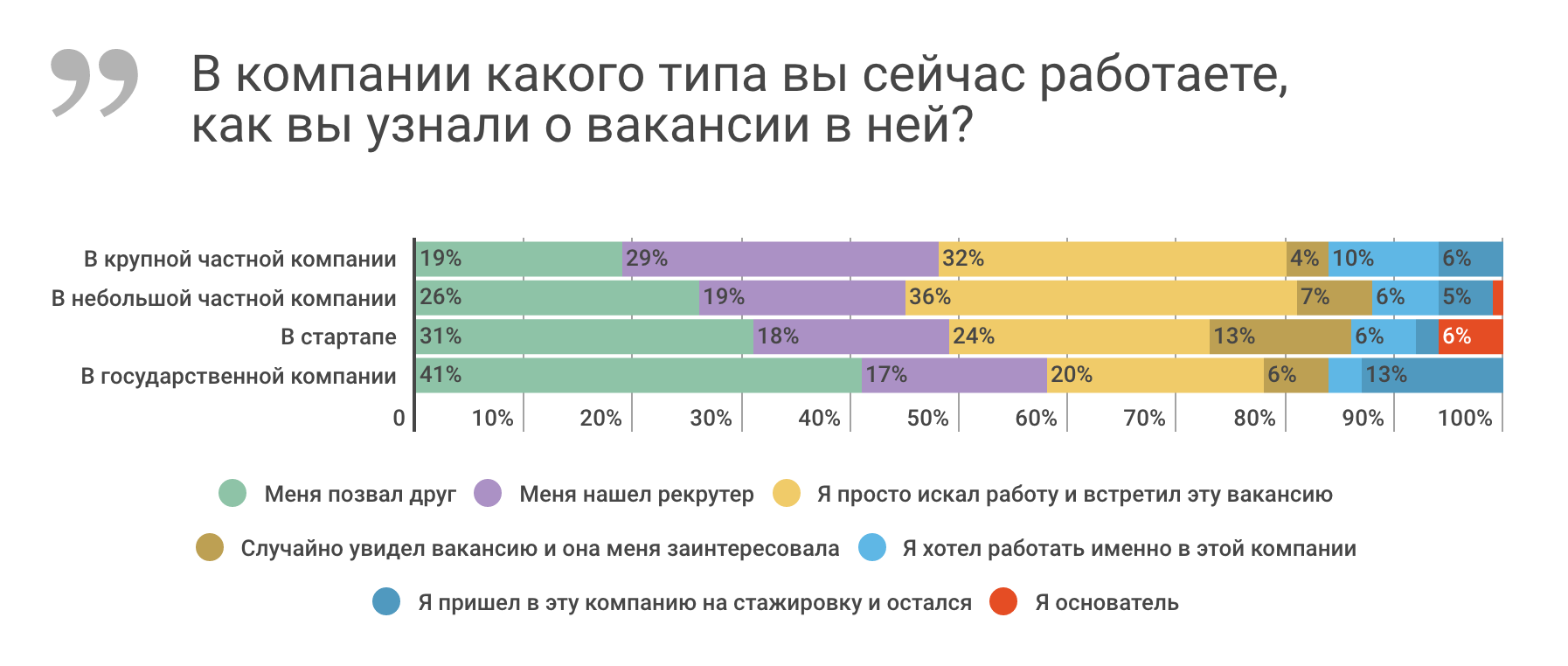
We all know that new specialists come to IT companies, including on the recommendation of their friends already working in the company. It turned out to be some surprise to us how great this factor is.
On average, most often they find work on their own, responding to a posted vacancy - every third said this. But the friend’s recommendation turned out to be in second place in frequency - every fourth came to the current company in this way. Every fifth finds a recruiter. Every twelfth initially wanted to work in this company.
This is an average. And if you look at how the above factors are distributed depending on the type of company, you will see that the recommendation of a friend is the main channel for attracting employees in state-owned companies and startups. And for small private companies, this factor is much more significant than for large ones.
The recruitment of new employees with the help of their friends already working in the company does not require direct cash costs from the company. Unlike posting vacancies or using the services of recruiters (both internal and external). Therefore, it is very important to understand under what circumstances this channel will work. This understanding will continue.
To do this, we need to attract the “NPS Loyalty Index” (Net Promoter Score). This technique was first proposed in 2003, and since then has gained immense popularity for decision-making in the field of business, product, marketing, and personnel management.

In short, NPS is considered so. The respondent is asked: “How likely is it that you recommend company X to your friends / acquaintances?” And it is proposed to evaluate this probability with a number from 0 (I definitely will not recommend it) to 10 (I would definitely recommend it).
Then we look at those who indicated 9 or 10, we call them “supporters”: these are those who will most likely recommend to friends. Who indicated 7 or 8, we call it “neutrals”: these are most likely passive people who will not do anything at all. And finally, those who indicated from 0 to 6 are called “critics”: those who are more likely to not recommend to their friends, and at low ratings, on the contrary, will dissuade their friends.
Next, we subtract the percentage of “supporters” from the percentage of “critics” and get the desired “loyalty index”. It can vary from -100 (some “critics”) to +100 (some “proponents”). It is believed that if it is positive, then organic growth is possible only due to loyalty. And if it is very large, then growth is possible without additional advertising. Conversely, at low rates, a fall and a contraction are possible. Learn more about the method .
First, let's see how the type of company and its fame affect the willingness to call your friends to company employees.
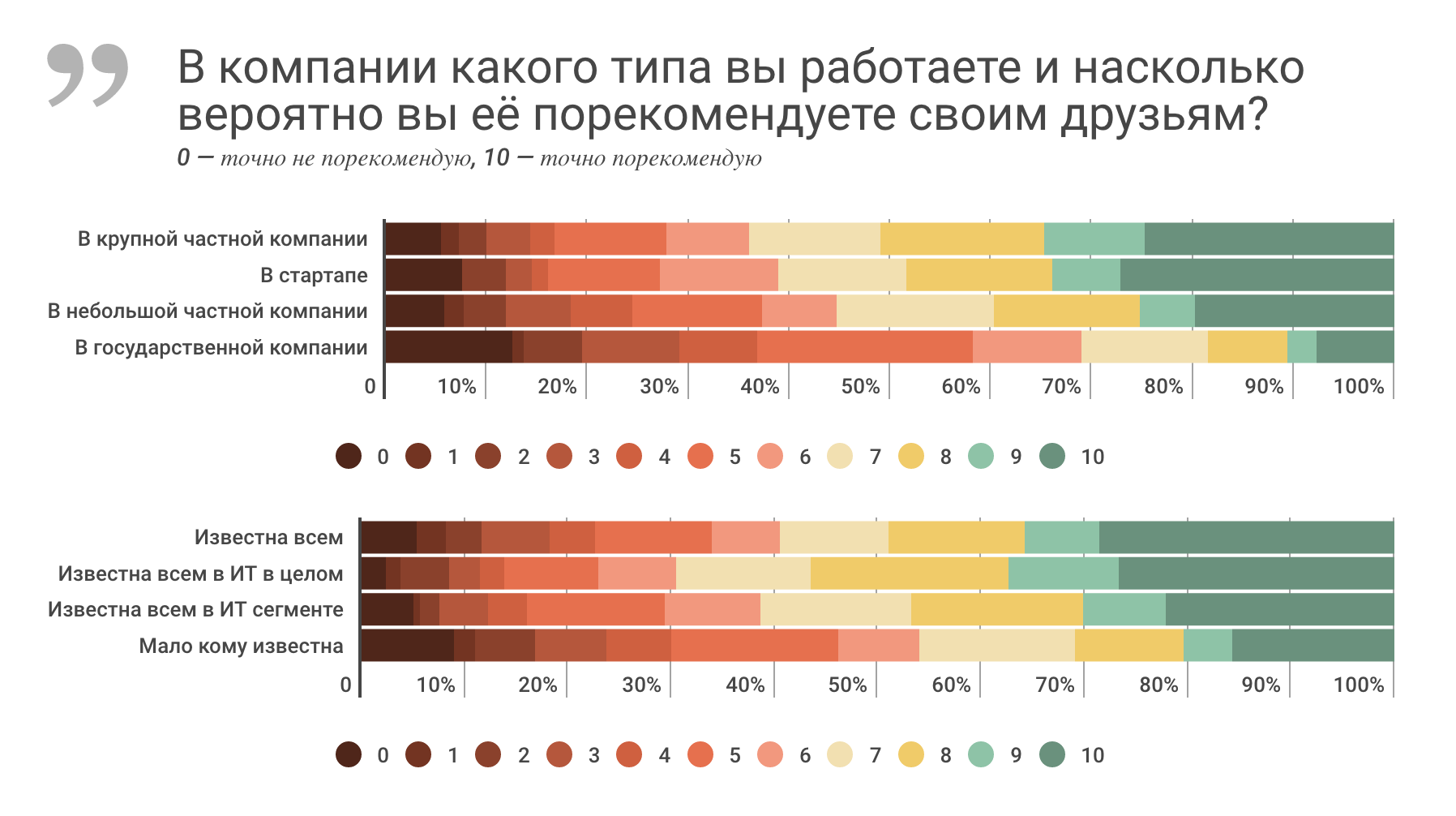
As you can see, those who work in a large private company or startup, or in a company that is known throughout the IT industry, are much more likely to recommend their company as an employer. And the least willing to recommend those who work for a state-owned company, or for a company that is unknown to anyone.
NPS is obtained as follows. As you can see, positive NPS only for companies that are well known in the IT industry as a whole, zero NPS for large private companies. A very negative NPS from state-owned companies and few well-known companies.

And how does the willingness to recommend your company affect the duration of work in this company or the remoteness of work in it? We see that with an increase in seniority, NPS decreases on average - according to another diagram, this is happening due to an increase in the share of “critics” with the same percentage of “supporters”. Those working in the office are a little more loyal to their company - there are fewer “critics” and almost as many “supporters” among them.
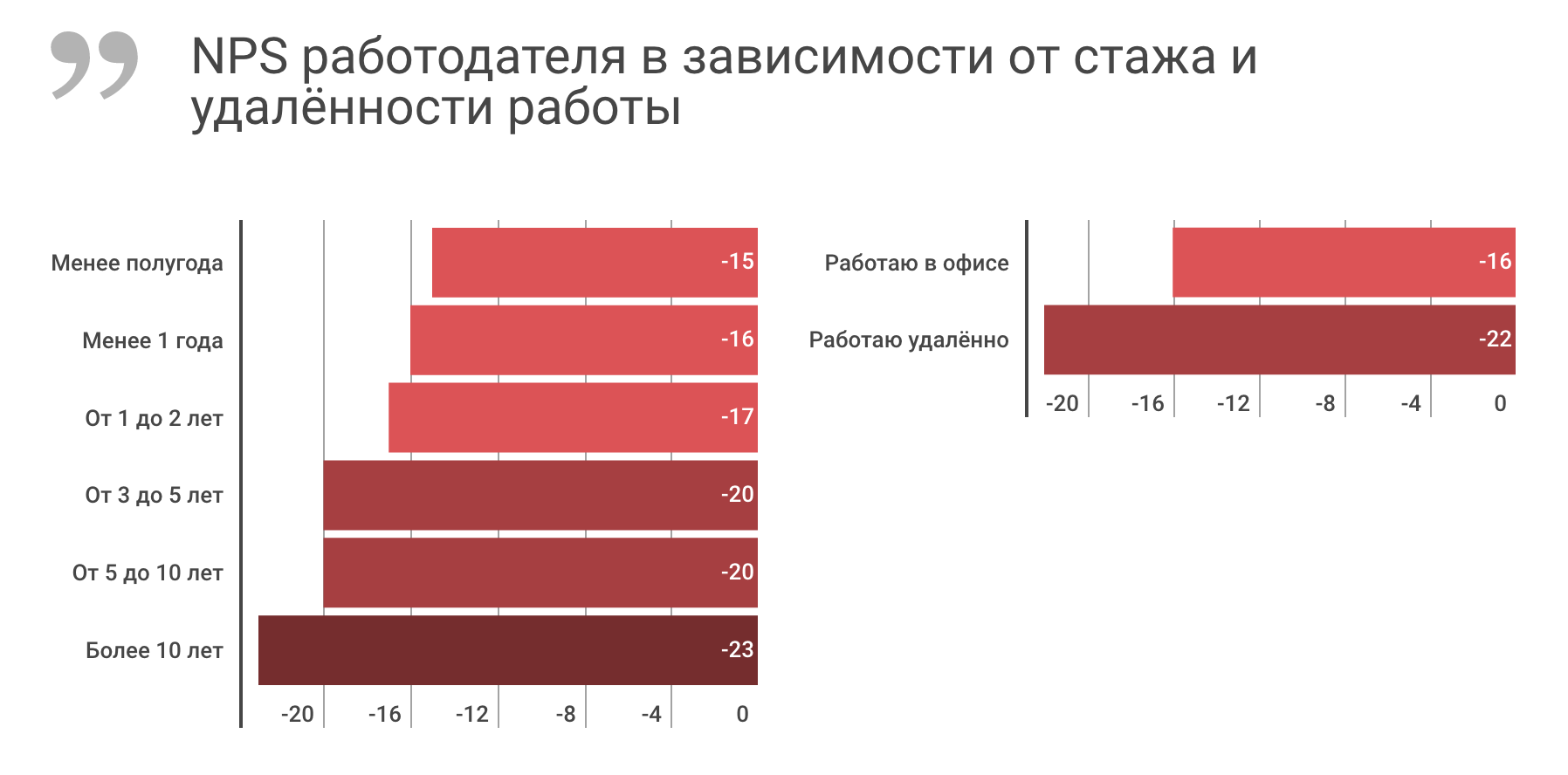
Until now, we have considered rather the external factors of the company, affecting the likelihood of calling your friends to your company. These factors are largely irresistible or difficult to overcome for companies.
But finally, we got to the most interesting. Namely, to those internal factors that the company can influence by management methods, without increasing cash costs. We identified 6 such factors, but in reality there can be many more. We asked on a scale from 1 to 5 to evaluate how much one factor or another was satisfied with the employee. And then they crossed these answers with their answers about their readiness to recommend the company as an employer to their friends. And here is what we got.
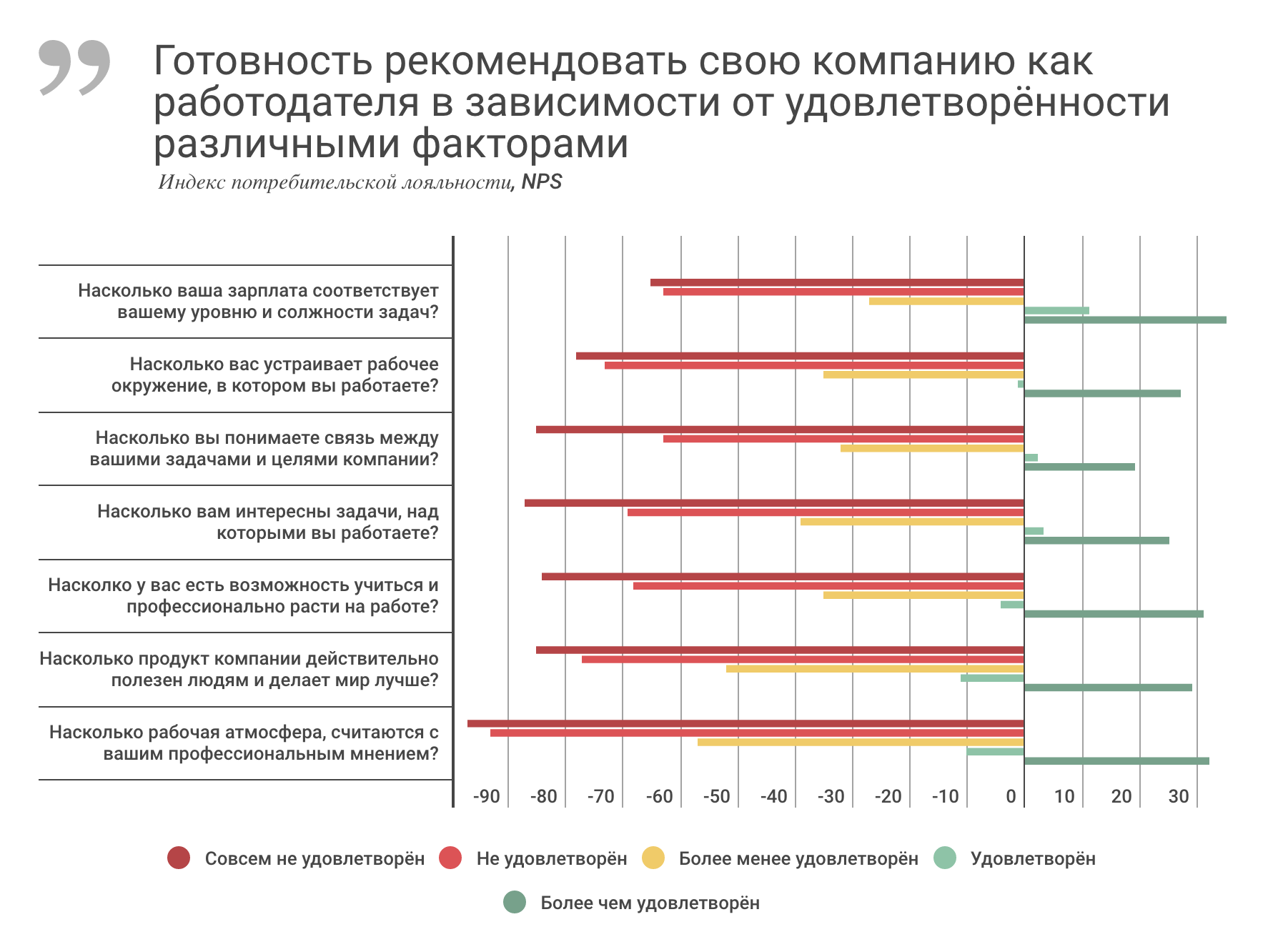
It turns out that if the satisfaction with the factor is average (more or less), then the NPS goes negative and fluctuates between -30 and -50.
A positive NPS can only be achieved by those companies that more than satisfy their employees. Moreover, this positive loyalty index will be approximately the same, in the region of 30, for all factors, but it will be slightly lower for the factor of understanding the connection of their tasks with the goals of the company.
Worst of all, loyalty is affected by disrespect for the professional opinion of the employee. According to this factor, NPS can very quickly reach -90! The strength of the potential negative impact is followed by a lack of understanding that people really need the company's product. Here NPS can quickly fall to -80. But dissatisfaction with wages, oddly enough, the least of all factors affects loyalty destructively. And it can only reach the -60 mark.
All diagrams were prepared using the infogr.am service .
The obvious answer is, of course, the salary! Yes, salary is really important, we often talk about it ourselves . But work is not only a place to earn money, but also a place where we spend a significant part of our lives, we communicate with colleagues more and more often than with friends and even family. A third of life, according to the most conservative notions, passes one way or another “at work”.
Do the numbers confirm that it is not only the salary indicated in it that is important for applicants who respond to a vacancy? Yes - we regularly see that the number of responses to the same vacancies, with the same salary, located in the same city, but related to different companies, can differ significantly.
In today's small study, we’ll try to take a closer look at those non-monetary factors that influence job choice. In the first part we will see who is ready to change his current job without changing his salary and why he is ready. In the second - how often new employees come at the invitation of friends and what affects this.

We interviewed more than 1600 people, users of "My circle" and "Habrahabr". We got the usual slice for us, the same as in all our other polls. Most of our respondents are programmers: backend and frontend developers, developers of mobile applications and software.


Part 1. What non-salary factors affect the choice of work for IT professionals
So what factors, in addition to salary, can determine the choice of work for an IT specialist? To find out, we asked everyone to answer the following question and received an appropriate distribution of answers.

It turned out that salary is the only condition for a job change only for every fourth IT specialist (highlighted in yellow on the diagram). Only 25% of respondents do not see any reason to change jobs if they are offered the same responsibilities with the same salary! For most, there are many other, additional, factors that can affect the final decision on a change of job.
In the first place - professional factors(highlighted in green on the diagram). Every second can go into a more interesting project. Two out of five may be carried away by more interesting technologies. One of the three is a more interesting area of the company.
In second place are comfort factors (highlighted in purple on the diagram). Almost one in three can be tempted by a good office and better working conditions. Every fourth - a more convenient work schedule or proximity to home. Every fifth - the presence of a social package. All these are material factors, somewhat close to salary.
However, this second place is disputed by a completely intangible factor - the value factor (highlighted in orange on the diagram). So, every fourth is ready to change jobs only because the values of the company coincide with his personal.
In third place are communicative factors (highlighted in blue on the diagram). One out of seven can go to another company if his friends are there or if a more interesting corporate life awaits him.
Finally, in fourth place are the factors of the company's prestige (highlighted in yellow on the diagram). One in ten can go without changing their salaries to a larger or more well-known company.
As you can see, most of the factors contributing to the choice of work are intangible or, more precisely, do not always directly correlate with money. If a company wants to attract specialists without increasing salary costs, it must be able to manage these factors and communicate its work advantages hidden from prying eyes.
We looked at the non-salary factors of job change in the industry as a whole. It will also be interesting to see how similar they are depending on the age or field of activity of the specialist.
4 age groups are highlighted below. The height of each color bar shows how many percent of people of a given age indicated that this factor could motivate them to change jobs without increasing their salaries.

As you can see, for young people in their student years more than for other age groups, fame, company size and company values are important, and less than others are important social package or proximity to home .
For the most adults who have crossed the 40-year milestone, closeness to home is more important than others and less importantacquaintances among colleagues, corporate life, fame or company size .
For young people from 20 to 30 years, compared with those who are from 30 to 40, acquaintances among colleagues, corporate life, fame and size of the company are a little more important .
Separate specialties are highlighted below. The height of each color bar shows how many percent of people in a given specialty indicated that this factor could motivate them to change jobs without increasing their salaries.

We see that for administrators and testers, in comparison with other specialists, the company's values are less significant, and for managers and designers more significant.
For testers, the proximity of work from homemore important than other professionals, and designers - on the contrary, it is less important than others.
For managers, the work schedule is more important than other specialists, and the interestingness of the project , oddly enough, is less important than others.
For designers and managers, interesting technologists are less important than other specialists, which is understandable, they do not work with code.
How do companies manage to convey their work advantages to their potential employees? To find out, we asked the following question.

It turned out that for more than 40% of respondents, their ideas about the working conditions in the current company were worse than they really are. This suggests that very, very many companies do not inform applicants of their advantages and advantageous qualities. Recently, by the way, we wrote about how it is worth communicating to an IT professional the benefits of a company using the example of registering a company profile on My Circle.
Part 2. How friends influence the attraction of new IT specialists in a company
In the second part of our study, we’ll try to figure out how IT specialists learn about their future work and what role word of mouth plays in this process.

We all know that new specialists come to IT companies, including on the recommendation of their friends already working in the company. It turned out to be some surprise to us how great this factor is.
On average, most often they find work on their own, responding to a posted vacancy - every third said this. But the friend’s recommendation turned out to be in second place in frequency - every fourth came to the current company in this way. Every fifth finds a recruiter. Every twelfth initially wanted to work in this company.
This is an average. And if you look at how the above factors are distributed depending on the type of company, you will see that the recommendation of a friend is the main channel for attracting employees in state-owned companies and startups. And for small private companies, this factor is much more significant than for large ones.
The recruitment of new employees with the help of their friends already working in the company does not require direct cash costs from the company. Unlike posting vacancies or using the services of recruiters (both internal and external). Therefore, it is very important to understand under what circumstances this channel will work. This understanding will continue.
To do this, we need to attract the “NPS Loyalty Index” (Net Promoter Score). This technique was first proposed in 2003, and since then has gained immense popularity for decision-making in the field of business, product, marketing, and personnel management.

In short, NPS is considered so. The respondent is asked: “How likely is it that you recommend company X to your friends / acquaintances?” And it is proposed to evaluate this probability with a number from 0 (I definitely will not recommend it) to 10 (I would definitely recommend it).
Then we look at those who indicated 9 or 10, we call them “supporters”: these are those who will most likely recommend to friends. Who indicated 7 or 8, we call it “neutrals”: these are most likely passive people who will not do anything at all. And finally, those who indicated from 0 to 6 are called “critics”: those who are more likely to not recommend to their friends, and at low ratings, on the contrary, will dissuade their friends.
Next, we subtract the percentage of “supporters” from the percentage of “critics” and get the desired “loyalty index”. It can vary from -100 (some “critics”) to +100 (some “proponents”). It is believed that if it is positive, then organic growth is possible only due to loyalty. And if it is very large, then growth is possible without additional advertising. Conversely, at low rates, a fall and a contraction are possible. Learn more about the method .
First, let's see how the type of company and its fame affect the willingness to call your friends to company employees.

As you can see, those who work in a large private company or startup, or in a company that is known throughout the IT industry, are much more likely to recommend their company as an employer. And the least willing to recommend those who work for a state-owned company, or for a company that is unknown to anyone.
NPS is obtained as follows. As you can see, positive NPS only for companies that are well known in the IT industry as a whole, zero NPS for large private companies. A very negative NPS from state-owned companies and few well-known companies.

And how does the willingness to recommend your company affect the duration of work in this company or the remoteness of work in it? We see that with an increase in seniority, NPS decreases on average - according to another diagram, this is happening due to an increase in the share of “critics” with the same percentage of “supporters”. Those working in the office are a little more loyal to their company - there are fewer “critics” and almost as many “supporters” among them.

Until now, we have considered rather the external factors of the company, affecting the likelihood of calling your friends to your company. These factors are largely irresistible or difficult to overcome for companies.
But finally, we got to the most interesting. Namely, to those internal factors that the company can influence by management methods, without increasing cash costs. We identified 6 such factors, but in reality there can be many more. We asked on a scale from 1 to 5 to evaluate how much one factor or another was satisfied with the employee. And then they crossed these answers with their answers about their readiness to recommend the company as an employer to their friends. And here is what we got.

It turns out that if the satisfaction with the factor is average (more or less), then the NPS goes negative and fluctuates between -30 and -50.
A positive NPS can only be achieved by those companies that more than satisfy their employees. Moreover, this positive loyalty index will be approximately the same, in the region of 30, for all factors, but it will be slightly lower for the factor of understanding the connection of their tasks with the goals of the company.
Worst of all, loyalty is affected by disrespect for the professional opinion of the employee. According to this factor, NPS can very quickly reach -90! The strength of the potential negative impact is followed by a lack of understanding that people really need the company's product. Here NPS can quickly fall to -80. But dissatisfaction with wages, oddly enough, the least of all factors affects loyalty destructively. And it can only reach the -60 mark.
To summarize
- In this small study, we showed that besides salary, there are many other factors that influence the fact that IT professionals choose to work in your company. Moreover, some of them can influence much more strongly: first of all, we are talking about professional factors such as design and technology.
- Work in more than 40% of companies is for the employee much better than he had originally expected. A lot of companies do not convey their employer's strengths to future employees. And the high salary has absolutely nothing to do with it.
- One of the main channels for attracting new employees is the recommendation of your friends by those who already work in the company. This channel does not require direct cash costs, and therefore companies should pay enough attention to it in order to attract good specialists without making higher salaries than others.
- There are many internal factors that increase the likelihood that current employees will recruit friends. The company can influence these factors again only due to internal organizational resources.
All diagrams were prepared using the infogr.am service .
